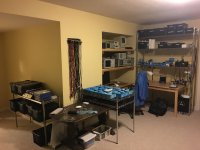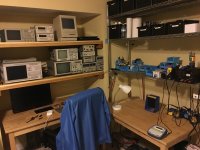Yes!! Emphatically so. In the past year, I’ve been getting my home lab up and running, working on my other electronic product, and figuring out how to develop a US-based factory to assembly my circuit boards.
I am still adamant about my direction of the project, emulating the 68k code on an ARM processor. I still think that the performance can rival and in some cases exceed a similarly priced FPGA-based solution. And I think the “switch to ARM” is a funny thing to make.
Technology and prices have changed in the past year. I posted pictures of a board with an STM32H7 processor running at 400 MHz and costing over $20. Now an iMXRT1050 at 600 MHz can be had for just $5.60. The iMXRT1050 also integrates two USB PHYs, further reducing cost over the old design. So I am going for this processor now.
I finished my lab, and I’m quite pleased with it:


I have also realized that in addition to a lab, what I need is a factory space with a robotic pick-and-place machine in which to do the assembly of not just my Mac products but also my other products. Hand assembly and contract assembly in China both did not meet my requirements in terms of cost and volume and my oversight. So I am working on the factory currently. My best friend will be running it. We are going to try selling audio products, test equipment, and vintage computer products, all of our own design. I think that with one or two very skilled operators and some new, cheaper-than-ever machinery, we can achieve lower assembly costs than anyone else offers for low-volume boards with many component placements (100+, mostly resistors and capacitors).
Now the bad news is that the setup cost for the board I want to make for the Maccelerator is some $500. This new cheaper processor is very small and requires a more expensive board. But the cost of the components in the design and the unit cost of each board are still low, and I think I can get the board design right on the first try.
Since all of this stuff is quite expensive, I will be offering up for sale much of my Mac and Apple II collection once I finish restoring it (using my lab of course) to try and eke back some of the costs. I have too many of some models, like I have 4 SEs and 4 LC IIs. IIgs machines are really going for a lot these days too and I have 3 of these. I also have a lot of Tektronix oscilloscopes which I will be selling once restored.
Talking about board design, another important topic I’ve been studying is signal integrity, and I think I’ve absorbed enough information on this subject to design boards with great performance and electromagnetic compatibility. This is really important.
So so that’s my progress in the past year in a nutshell.


